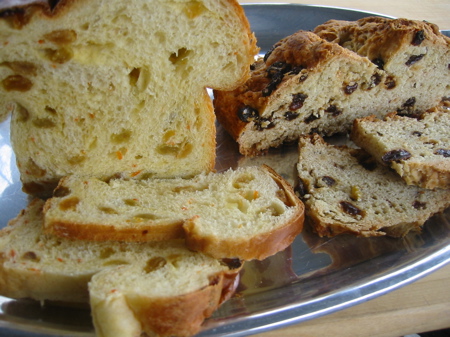Irish-ish Soda Bread

It’d be fun to hold a yearly contest for the least Irish version of Irish soda bread. For trust me ladies and germs, nobody — not even the Irish — want to eat the real thing. Taste it and you’ll understand why. Real Irish soda bread is dry, hard, mealy and packs a nasty alkaline bite. No wonder since it only contains four ingredients: flour, buttermilk (originally clabber), salt and soda. No fat, no eggs, no sugar, spices, dried fruit..none of the things, in short, that modern bakers put in Irish soda bread to make it acceptable to modern palates. Just a simple paste of coarse meal flavored with salt.
That’s because the Irish were poor. Dirt poor. Among the poorest of the poor in Britain (or anywhere in Europe for that matter) around 1800, when baking soda first came on the scene. Now as all those who’ve been reading along through these past many weeks of chemical leavening talk know, it was mostly hard-up Americans who where using baking soda in those days. However it didn’t take long for the even-more-hard-up Irish peasantry to adopt it. These were people who subsisted on a diet of potatoes, cabbages and other hardscrabble crops. They couldn’t afford to buy bread, they couldn’t even afford to make it, in the first place because flour was expensive and rare, in the second because dirt hovels don’t come equipped with convection ovens.
Soda was the perfect leavener for the 19th-century peasant-on-the-go. Unlike yeast starters that required maintenance and regular feedings (or at least a regular schedule of weekly bread making), soda could be used on whatever odd occasion flour came available. If you didn’t have your own oven nor access to a communal one, no problem, soda breads will rise well enough on a skillet. Sure it didn’t taste all that great by the standards of the wealthier, yeast bread-eating classes. But so what? To a peasant who ate nothing but cabbage soup every dang day it would have tasted like the food of the gods. Yet it’s little wonder that as soon as a lot of these folk emigrated to America they either abandoned their traditional soda bread for the local stuff or they added a lot of rich-folk fixin’s. Pictured above are examples of each purchased from a suburban Chicago bakery: an enriched yeast “freckle bread” and a more traditional-style soda bread full of raisins, fat and caraway seeds. Both are as delicious as they are un-Irish.
So OK it’s a pretty boring story. Much more fun to believe the blarney the popular food press is going to try to feed you today, about how Irish soda bread was invented by druids, American Indians, Vikings, peasants who only had high-gluten flour or monks who couldn’t eat yeast during Lent. But who are you going to believe, that lot of phonies or your good buddy Joe?